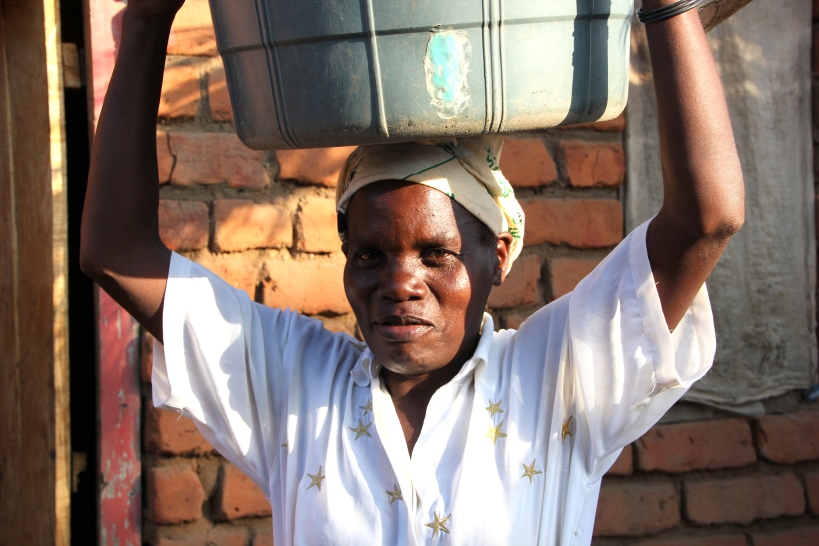 Most days on the road with Heifer are really good days. And some are just hard.
Most days on the road with Heifer are really good days. And some are just hard.
The last day we spent visiting projects in Malawi was a hard one – not because of what we did but because of what we saw. We were visiting the Khongoni project near Lilongwe that supports people with HIV/AIDS by providing them with training, trees, seeds, and milk-producing goats. I expected the towns close to the capital city to be more affluent, but in fact they were some of the poorest communities in this very poor country.
Our first visit was with Hardwell Chidesmbo –a HIV-positive father of 16 (yeah, that’s right) whose first wife died of AIDS, leaving behind 8 children. With his second wife (also HIV-positive) he has had another 8. That boggled my mind but far worse, the children were dirty, frantic and hanger-thin. The entire household seemed teetering on the verge of neglect and one little lamb had a broken leg. One of Hardwell’s daughters was disabled and another had died, leaving behind an infant daughter who was also HIV positive. The situation seemed more than any mere livestock could improve.
And yet, Ginison Moliyere, the local Community Animal Health Worker that Heifer has trained to provide animal services, was not feeling discouraged. He told me that Hardwell’s family had only just received the goats so he felt there was plenty of time for them to progress and improve their situation. Ginison had come to splint the lamb’s leg after it tumbled out of its new shed and it’s now healing well.
I can’t tell you how this young man’s dedication moved me. Ginison spends 2 days each week on his Heifer bike, traveling the 15 km. radius of this project and helping people keep their goats robust and healthy. Ginison helps them do that with advice, encouragement, and hands-on training (and the government provides anti-retroviral drugs). And he does it all as a volunteer.

Belvin Manda and Victor Mhango from the central Heifer office, going over records under Ginison’s goat’s watchful eye.
Ginison also gives vaccines, keeps impeccable records for 5 groups of about 250 recipients, and is raising two goats of his own (although one of his pregnant goats died the day before – a big setback). But at age 39, HIV-positive, with six children of his own and a new wife (his first wife died), Ginison doesn’t seem to sweat the small stuff; he is tremendously dignified and remarkably resolute. His household is neat as a pin, his children are all in school, and clearly he has a gifted way with animals.
Despite his volunteer status (farmers do pay him a small fee and eventually it should become a business), Ginison’s role could not be more important. Heifer’s project is a joint effort with the National Association of People Living with HIV and AIDS (PLWHA) and will reach 1,000 HIV-affected families with meat or dairy goats to improve their income and nutrition (goat milk is easier to digest than regular milk and has been shown to increase white blood cells). If it weren’t for people like Ginison willing to offer day-to-day support to the project beneficiaries and extend the reach of Heifer staffers, there is no way this project could reach its goals.

Although 1 in 7 Malawians have HIV/AIDS, the numbers are going down – hopefully fast enough to protect the next generation.
Some people like Hardwell, with his 16 ragtag children, seem almost beyond the reach of Heifer’s battery of trainings. (Although Heifer’s gender equity and family health trainings are certainly encouraging people to control their own reproductive future — and of course, educating girls has been proven to be the most effective route to decreasing family size, and Heifer is all about keeping kids in school.) While it would be naive to think that every Heifer story would be one of immediate success, it was still difficult not to feel some despair at the prospects for Hardwell’s family.
But then Ginison took us to meet Rebecca Mzingwa… and she was nothing short of an antidote and an inspiration.
In August 2011, this HIV-positive widowed mother with 3 children and 1 mere acre of land received 2 goats from Heifer. In September, her goats gave birth to 2 more, she passed them on to another HIV family, and since then, her goats have kidded again (I love that phrase) and now she has 5 healthy thriving goats. She sells 3 liters of milk every day (saving ½ liter for herself and 8-year old Bernard) collects grass from the public wetlands every day to feed her goats, and raises maize and vegetables on her 1 acre, fertilized with goat manure.
In 2-3 years, she wants to have 20 goats and I don’t doubt for a minute that she’ll do it.
“My children are orphans so I need to support them with these goats,” she says confidently, as Bernard snuggles up to her. “I am very healthy and very strong. I am fine.”
She’s more than fine; she is a woman with a plan. And some very healthy goats.






















































